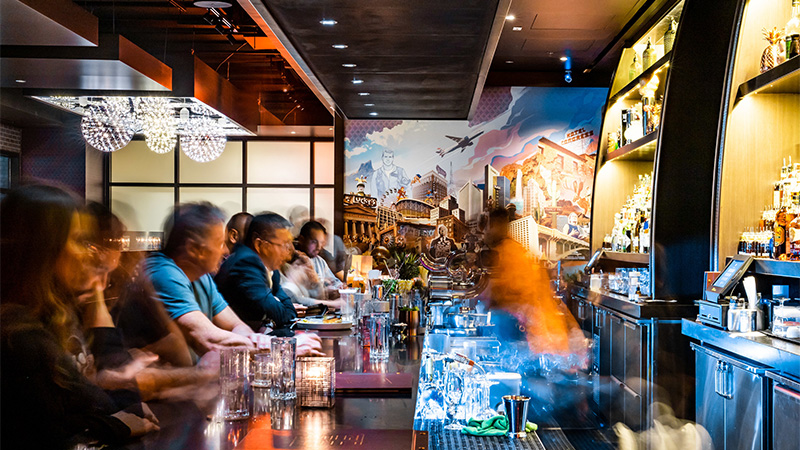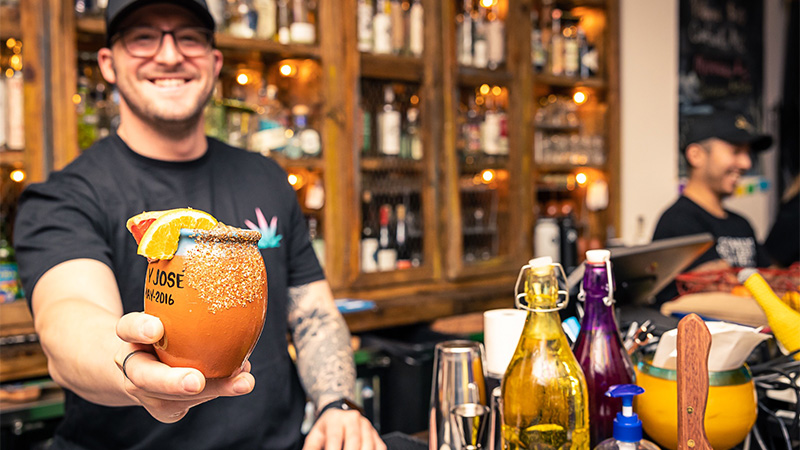For most of the 25 years I’ve lived in Phoenix, the city’s biggest draws seemed to be golf and retirement. Anything other than that felt like it sat on the sidelines — particularly the dining and drinking scene. But something has been shifting over the last decade and now you’re just as likely to find a quality cocktail bar as you are an 18th hole.
Phoenix has been growing in population steadily over the last 10 years but it’s who is moving here that’s greater impacted the city’s drinking landscape. The Valley is attracting tech companies and middle-class Californians, and the city has the 14th-lowest median age in the country. Now, we have a drinking population that is clamoring for more — and they’re getting it.
When Four Peaks Brewing Company started 25 years ago, co-founder Andy Ingram saw that Phoenix was a particularly underserved market. “It was a total gamble mixed with a lot of hubris,” he says. “I don’t think any of us had the vision of where craft brewing would eventually go.”
Don’t Miss A Drop
Get the latest in beer, wine, and cocktail culture sent straight to your inbox.
Similarly, Ross Simon, owner of Bitter & Twisted Cocktail Parlour and co-owner of Little Rituals, moved to Arizona from the U.K. in 2005 with the idea of opening a cocktail bar in Phoenix. But the concept hadn’t been proven yet. “Trying to raise the money to do that was a gargantuan task of basically having people saying ‘No, I don’t think it works,’” he says.

Ingram found himself fighting an uphill battle against Phoenix’s decidedly transient residents. “They wanted something from Pittsburgh or Florida or wherever they’re from. Nobody wanted something local,” he says. “That was the longest sustained educational piece — saying ‘Hey, you’re here now; this can be your beer. I think we accomplished that but it took a generation.”
After nine years, Simon finally opened Bitter & Twisted in 2014. To build a base before he opened shop, Simon had to convince his potential market of what they were missing out on. He did so by helping co-found both the Phoenix chapter of the United States Bartenders’ Guild and Arizona Cocktail Weekend.
Having just celebrated its 10th anniversary, Arizona Cocktail Weekend has grown into a premier event that now brings in some of the world’s most notable bars to host pop-ups, competitions with renowned local mixologists, and showcase some of the best locations in Phoenix. In a way, the expansion of Arizona Cocktail Weekend has become a metaphor for Phoenix’s own evolution in the beverage space.
Simon takes his role in educating the Arizona public seriously. “We look at Bitter & Twisted as a gateway for converting people who might not necessarily be cocktail fans or drinkers,” he says. “They see all these amazing cocktails and the bartenders craft their drinks and go, ‘Okay, I’ll give this a chance.’”
That education has helped spur the advent of more specialized bars, like the agave-focused BARCOA Agaveria, which opened in November 2021. “The city’s started checking boxes in terms of categories,” says co-owner Dave Tyda, pointing to Phoenix’s tiki bars, craft cocktail hangouts, and award-winning mixologists. “The fact that these places survive tells us the consumer base is growing,” he says. “They’re engaging with new ideas, and willing to support if executed properly.”
One area the city has struggled with in the past is the lack of a structured downtown for residents and visitors. Growing up here, there was no reason to visit downtown other than for the occasional baseball or basketball game. But hanging out there before or after said game? No point.
Yet, the local government and voters have used those teams as a jumping-off point to support a bigger convention center and allow Arizona State University to expand into a downtown campus. In 2008, a light rail was added to provide usable pedestrian transport in the neighborhood’s maze of one-way roads and limited parking. Combined with the continuous growth in employment, downtown now supports more workers, professionals, and students than before, and has become accessible and attractive.
Josh Landers, a commercial real estate broker with Commercial 33, has been in the Phoenix real estate business for 20 years. He’s watched as the demand for food and beverage spaces has steadily increased over the last five to 10 years.

While consumers may only notice the influx of new bars and restaurants, Landers says the demand for kitchen, bottling, and production spaces is even greater — another sign of the city’s evolving eating and drinking landscape. With the simultaneous influx of residents downtown, Landers has also witnessed more residential density in urban pockets and a shift in consumer spending patterns from grocery stores to restaurants and bars.
“Demand for food and beverage spaces (F&B) plays an impact in almost every aspect of the commercial market,” Landers says. “A strong F&B marketplace absorbs vacant space and drives demand for urban living. It becomes a de facto ambassador to the revitalization happening in the downtown market.”
BARCOA’s Tyda, and his main partner in the business Ryan Oberholtzer, firmly believe in the potential of downtown Phoenix. So, too, does Bitter & Twisted’s Simon, who attributes his optimism to the area’s population density and the ability of patrons to simply walk to bars and restaurants.
While Phoenix has officially come into its own as a drinking destination, the professionals agree it’s a fragile world to enter. While Four Peaks is now a beloved Phoenix institution (albeit one that’s been owned by AB InBev since late 2015), it’s competing for drinkers who also want wine and quality cocktails, Ingram says. On the latter front, Simon points out that some cocktail bars are now implementing draft systems, which in turn devalue the very role and importance of bartending he and others worked so hard to highlight. “They can get someone that looks pretty covered in tattoos and mustaches, and they just pour the drinks right from the tap,” he says.
On the other hand, this scenario does nod to how far the city has come in its beverage offerings and the preference of drinkers. According to Tyda, there is a positive way to look at things: “The flip side is if that’s what gets someone into the cocktail scene, then they start poking around to find some of the more classic places.”
“We’ve got such a great community,” emphasizes Simon. “We’re seeing so many great cocktail bars that are actually getting taken seriously.”